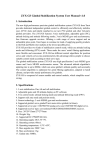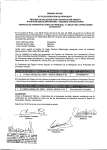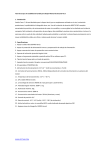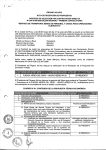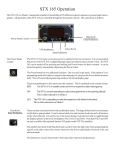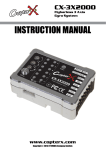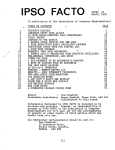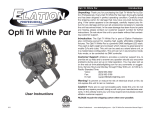Download GU-INS Manual - Global RC Hobby
Transcript
Assembly Instruotion GAUI ●Specifications: 1.Dimensions:Main controller: 53.5 x 38.5 x 12mm GPS antenna: 42 x 34 x 15mm Weight:Main controller: 27g (w/o cables ), GPS antenna: 23g (with cable) 2.Frequency: 300Hz output to ESC 3.Operating temperature: -20~80°C 4.Operating modes: Rate (manual) mode, Auto balance mode, GPS positioning mode. 5.Rate (manual) mode: Max angular velocity: 300 degree/sec. 6.Auto balance mode: Max tilt angle: 60 degree. 7.GPS positioning mode: a.Hovering accuracy: Horizontal: ±2m, Vertical: ±0.5m b.Max yaw angular velocity: 250 degree/sec c.Max tilt angle: 45 degree. d.Max horizontal speed: 10 m/s,36 km/hr e.Max vertical speed: 8 m/s (horizontal posture) 8.GU-INS provides pitch and rolls output signals, can work with different types of camera mounts. 9.Fail-safe functions: Automatic Go-Home, Signal lost Go-Home, Low voltage protection. 10.Suitable wind condition: < 10 m/s Index Note Index for LED Light Status ᐸဵᄈྲߓ System Assembly P1 P2 System Setting P3~5 P6~7 System Tuning P8~10 GPS Navigation P11~15 Go-Home Function Low Voltage Protection P16~17 P18~19 P20~23 Camera Gimbal Calibration Firmware Update P24~25 On Screen Display Interface(Option) Content P26~27 Two channel connection cable Ρၿഀ௦ጤ GU-INS main controller HV.JOTҐᡞ Damper sponges ٪Ꭻݿෞ Assembly Instruotion ᐈձᇴ݃ਫ GAUI ●Specifications: ੀ 1.Dimensions:Main controller: 53.5 x 38.5 x 12mm GPS antenna: 42 x 34 x 15mm Weight:Main controller: 27g (w/o cables ), GPS antenna: 23g (with cable) 2.Frequency: 300Hz output to ESC 3.Operating temperature: -20~80°C 4.Operating modes: Rate (manual) mode, Auto balance mode, GPS positioning mode. 5.Rate (manual) mode: Max angular velocity: 300 degree/sec. 6.Auto balance mode: Max tilt angle: 60 degree. 7.GPS positioning mode: a.Hovering accuracy: Horizontal: ±2m, Vertical: ±0.5m b.Max yaw angular velocity: 250 degree/sec c.Max tilt angle: 45 degree. d.Max horizontal speed: 10 m/s,36 km/hr e.Max vertical speed: 8 m/s (horizontal posture) 8.GU-INS provides pitch and rolls output signals, can work with different types of camera mounts. 9.Fail-safe functions: Automatic Go-Home, Signal lost Go-Home, Low voltage protection. 10.Suitable wind condition: < 10 m/s User manual ٻңᇴ݃ਫ Six channel connection cable ϳၿഀ௦ጤ USB cable VTCഀ௦ጤ GPS system HQTقಜ Note 1.This product is NOT a toy, please keep away from crowd and buildings while flying. 2.Do not use this product for illegal purposes, or shall be responsible for breaking the law . 3.For your safety, please remove the propellers before setup and calibration procedures. 4.The throttle calibration procedure is very importnat (P.6), it calibrates not only the signals of ESC, but also central position of the transmitter. Therefore, do not move other sticks or switches except throttle stick; if you change the transmitter, make sure you execute the throttle calibration procedures. 5.The calibration of magnetic north and due north needs to be done throughly (P.14), or the 500X will slant or circle under GPS positioning mode.. 6.Under GPS positioning mode, all movements of the 500X are based on the speed signals of GPS. Therefore, if the GPS signal is bad or interfered, the 500X will become uncontrollable. If so, please switch back to auto-balance mode. 7.Do not insert the GPS antenna indoor, the 500X will become uncontrollable due to bad signal reception. (You can still apply altitude maintaining function under GPS positioning mode as long as you unplug the GPS antenna.) 8.Fly the 500X in an open area, and keep away from buildings. The GPS signal might be interfered due to signal refraction from buildings. 9.Under GPS positioning mode, please keep the 500X away from magnetic materials, such as hovering above the iron plate, the magnetometer inside the GU-INS will be interfered and result in instable of heading. 10.Keep the GU-INS away from magnetic materials (irons, screws, motor and magnet), those will interfere the GU-INS. (The screws of GU-INS are made of copper.) 11.If the 500X can not make a 360 degree turn, it reprents that the magnetometer of GU-INS is interfered. Please keep away from sources of interference or execute the calibration process. (Please visit GAUI official website for detail information.) 12.When the wind is getting stronger, we suggest to take off and land with auto-balance mode. Under GPS positioning mode, altitude maintaining function would be interfered by change of air pressure. Therefore, it would be more dangerous while the 500X is close to the ground. 13.You can activate the fail safe function on your tansmitter, set AILE, ELEV, THRO, and RUDD stick to its central position, and assign the F/S to activate “GPS positioning” and “HOME” function for further protection. 14.You can download the latest firmware from the official website of GAUI. 1 Index for LED Light Status 1 sec 1.SET: Off---- Normal Flashes 3 times and turn off---- Setup is completed. Solid---- Execute low voltage protection function. 2.GPS: Off---- GPS system is not inserted. Fast flashing---- Execute “HOME” function. Slow flashing---- Searching GPS signals. Solid---- GPS signal searching procedure is completed. 3.MODE: Slow flashing---- Manual mode. Fast flashing---- Auto-balance mode. Solid---- GPS positioning mode. Fast RED flashing---- Low voltage protection function is activated. Solid RED---- System error, please restart the system. 4.SENSOR: Green ---- System works fine. Red ---- System error, please restart the system. 2 System Assembly 1.Install the damper sponges to the corners under GU-INS. *Please keep GU-INS away from magnetic material. 2.Install the GU-INS to the center of the platform. 3 System Assembly Green/Blue (MODE) (H) *The main controller of GU-INS is aeolotropic. The arrow on GU-INS represents the direction of the main controller. Red/ /Black (B) (P CAM) White/Red/Black (AIL) Red/Orange/Yellow (R) (E) (T) 3.Insert the 2 and 6 channel connection cables to the GU-INS main controller. tion irec D ose N 4.Insert the plugs of ESCs (1~4) to the given sockets of GU-INS. (Notice the position and spinning direction of the motors.) 4 System Assembly White/Red/Black Red Orange Yellow AILE ELEV THRO RUDD Green Blue Black FLAP(Mode) GEAR(Go Home) AUX2(Camera Mount Pitch Axis) 5.Insert the plugs of receiver to GU-INS as illustrated. Futaba Normal AILE ELEV Normal THRO Reverse RUDD Normal JR Hitech Reverse Normal Reverse Reverse Normal Normal Reverse Normal 6.Create a model as “Airplane” in transmitter, confirm the “REV” setting as illustrated. A B C 7.Assign “MODE” (green wire) to the 3-positions switch (A) on the transmitter (as illustrated), “H” (blue wire) to the 2-positions switch (B) on the transmitter, and “P CAM” (black wire) to the side lever (C) of the transmitter. 5 System Setting 1.For your safety, before setup, please remove the propellers, and notice the LED lights on the GU-INS. MODE 1 2.Turn on the transmitter, and move the throttle stick to its top position. 3.Connect the battery to the 500X, the motors will come up with corresponding tones, and the LED light of “MODE” lights “ Red flashing”. MODE 1 4.Then move the throttle stick to its lowest position. 5.The motors will come up with corresponding tones, LED light of “MODE” lights “Solid green”, and the calibration of ESCs is completed. 6 System Setting Manual mode Auto-balance mode GPS positioning mode Off “Home” function 6.Then confirm the LED light of “MODE” and “GPS” in each fly mode; pay attention to the functionality of each switch position (as illustrated). You can also connect 1~2 satellite receiver instead of standard receiver, 6 channel connection cable is unnecessary while using satellite receiver. While setting the transmitter, please assign the functions (Home, Mode, etc) to the 2 or 3 positions switch and levers, and confirm again how it works according to the status of the LED lights. Ex: channel assignment for JR DSX7 and DSX9: Home function Fly mode Camera gimbal Insert the “Bind plug” to the “AIL” slot before binding the transmitter and GU-INS (For your safety, please remove the propellers before binding.) 7 System Tuning 1.Install the propellers, turn on the transmitter, and switch to “Manual” mode. 2.Connect the battery to the 500X, after the corresponding tones of ESCs, you are ready for test flight. MODE 1 3.Move the throttle stick gradually until the 500X slightly lift off. MODE 1 4.Move the “ELE” stick upward to check and make sure the 500X tilts forward as illustrated. 8 System Tuning MODE 1 5.Check and make sure the “AIL” movement follow your transmitter command. MODE 1 6.Check and make sure the “RUD” movement follow your transmitter command. The recommanded initial setting of GAIN and Z GAIN value is about central position of the knob. (as illustrated) 7.After checking all movements of the 500X are correct, hover the 500X about 1m above the ground, if it shakes or wags while hovering, decrease the “GAIN” value until it is stable. 9 System Tunning 1.5m 8.Hover about 1.5m above the ground, calibrate the attitude of 500X with trimmers of the transmitter. 9.Press “SET” buttom when calibration is completed. 12.Switch to “Auto-balance” mode, and calibrate the attitude of 500X with trimmers of the transmitter. 10.“SET” LED light flashes three times when calibration under manual mode is completed. 11.Set all trims to neutral after calibration. 13.Press “SET” bottom when calibration is completed, then set all trims to neutral after calibration. (GPS positioning mode does not need to be calibrated.) 10 GPS Navigation 1.Install the GPS system on top of the canopy with twin adhesive tape, insert the plug to the given socket (GPS) on the GU-INS. (The GPS system is not aeolotropic, the mark on top of it should be faced upward.) 2.Turn on the transmitter. 3.Connect the battery of the 500X, the LED light of “GPS” will start to flash, and the GU-INS will start to search for GPS signal. 11 GPS Navigation 5.You can verify how many satellites are received by pressing the buttom and count the number of LED flashes(as illustrated). 4.When the GU-INS has found more than five satellites, the LED light of “GPS” will turn solid green. We recommand to wait one more minute. Up Set Down MODE 1 6.Switch to “GPS positioning” mode, the LED light will turn solid green (as illustrated). 7.The definition of throttle stick under “GPS positioning” mode is as illustrated above. MODE 1 8.To lift up, move the throttle stick upward slowly over its central position. 9.Until the 500X has climbed to the altitude you want, move the throttle stick back to central position. 12 GPS Navigation MODE 1 10.You can also take off with “Auto-balance” mode (turn switch as indicated above), the MODE LED light will turn into fast green flash. 11.Climb to the altitude you want, and switch back to “GPS positioning” mode. MODE 1 12.Move the throttle stick upward, and the 500X will start to climb. MODE 1 13.Move the throttle stick back to neutral position, the 500X will maintain its altitude. 13 GPS Navigation MODE 1 14.Move the throttle stick downward, the 500X will start to decend. MODE 1 15.If the 500X heads to the left while you move the “ELE” stick forward, please adjust the “HEAD” knob to the right, this is the calibration of magnetic north and due north of different area. 14 GPS Navigation MODE 1 16.Z gain is used for adjusting the gain value of altitude, it may be affected by wind or air pressure, thus we recommand to adjust it to central position (as illustrated). MODE 1 17.The 500X can decend slowly to the ground under GPS positioning mode. 18.The propellers would not stop until switched back to “Auto-balance” or “Manual” mode. MODE 1 19.You can also land by switching to “Auto-balance” or “Manual” mode in the air. 15 Go-Home Function 1.While just starting the GPS system, the “Home” position may be within a radius of 5m. 2.By increasing the numbers of satellites received and wait for convergence of signal, the precision may increase to be within a radius of 2m. 3.Then press “SET” buttom under GPS positioning mode will make the “Home” position setting to be more accurate. (LED light of “SET” flashes.) . 4.When you move the 500X away to a new location, and would like to reset “Home” position, just press “SET” bottom under GPS positioning mode to reset “Home” position. 16 Go-Home Function 10m 5.When switching to “Home” function, the 500X will turn its head toward “Home” location and start returning to “Home” position. If its altitude is more than 10m, it will decend to 10m height after arriving at “Home” position. If its altitude is below 10m, it will maintain altitude and hover. You can still give orders like yaw or decend while the 500X is returning to “Home” position. 6.If you would like to operate after returning to “Home” position, remember to switch back to “Manual” or “Auto-balance” mode. 17 Low Voltage Protection 1.When you first insert the plug to the second cell (positive pole) of the balance plug of battery, and then connect the battery to the 500X, the low voltage protection function will be activated. (LED light of SET turn solid.) 2.If you connect the battery to the 500X first, then insert the plug, the low voltage protection function will not be activated, but the voltage will be shown on the OSD. LV 3.No matter which kinds of batteries you use (2~4S), insert the plug to the second cell (positive pole) of the balance plug. HV 4.Due to the variation in performance among different batteries, you will be able to adjust the activated voltage for low voltage protection function. 18 Low Voltage Protection MODE 1 MODE 1 5.When the low voltage protection function is activated, the throttle signal will decrease 20%, and the 500X will decend. 6.You need to move throttle stick upward more to maintain altitude and hover at this time. (This means you need to land the 500X as soon as possible.) Up Set Down MODE 1 7.In GPS positioning mode, the “Set” point of throttle will move 20% upward. (If you hold the throttle stick at the central position, the 500X will still decend.) 8.When the low voltage protection function is activated, the LED light of “MODE” will turn red. 19 Camera Gimbal Calibration Horizontal axis servo Vertical axis servo 1.Insert the wire of vertical axis servo to “P-CAM” socket, wire of horizontal axis servo to “R-CAM” socket, and place the 500X on a flat platform for the follow calibration and setting procedures. 2.Adjust the neutral position of horizontal axis servo for making the camera gimbal level. 3.Adjust the range of vertical axis as you want with side lever of the transmitter. 20 Camera Gimbal Calibration 4.For your safety, please remove the propellers before setup. 5.Turn on the transmitter first, and then connect the battery of GU-INS the 500X, press “SET” buttom before the initialization of is completed. A 6.The system will start the calibration procedures. (LED light of “SET” flashes.) 7.The angle of the camera gimbal presents would be datum line A. (The servo will return to its central position.) 21 Camera Gimbal Calibration A MODE 1 9.Press SET buttom to confirm, then the second LED light (GPS) flashes. 8.Raise one side of the pole (vertical axis of camera gimbal), calibrate the camera gimbal with ELE stick, adjust the camera gimbal to be parallel to datum line A. A MODE 1 10.Raise the other side of the pole (vertical axis of camera gimbal), adjust the camera gimbal with ELE stick to be parallel to datum line A as previous step. 11.Press SET buttom to confirm, then the third LED light (MODE) flashes. MODE 1 12.Raise one side of the pole (horizontal axis of camera gimbal) , adjust the camera gimbal to level with AIL stick. 13.Press SET buttom to confirm, then the “MODE” LED light will turn red flash. 22 Camera Gimbal Calibration MODE 1 14.Raise the other side of the pole (horizontal axis of camera gimbal) , adjust the camera gimbal to level with AIL stick as previous step. 15.Press SET buttom to confirm, then the LED lights of SET, GPS, MODE, SENSOR will flash then turn off, and the calibration of camera gimbal is completed. A A You can also only adjust the vertical axis of the camera gimbal, press SET buttom twice to ignore the calibration procedures of horizontal axis servo. Or you can ignore the calibration procedures of vertical axis servo by pressing SET buttom twice, and adjust only the horizontal axis servo. 23 Firmware Update 1.For your safety, please remove the propellers before software update. 2.Turn on the transmitter first, then connect the battery of the 500X (remove the canopy). PC 3.Connect the USB cable to the PC, it will download the driver automatically. 5.Download the firmware from the official website of GAUI, and double click the .exe file. Follow the steps to finish installation. 4.Insert the other end of USB cable to the OSD socket of GU-INS. 6.Select the appropriate COM (the system will search it automatically). 24 Firmware Update 7.Then click “Execute”. 9.As the updating procedures is completed (as display on PC), the sounds of ESCs will stop, LED light of “MODE” will turn off, then disconnect the battery of the 500X. 8.The system will start to execute the firmware updating procedure (the ESCs will come with sounds, LED light of “MODE” turn red flash). 10.Remove the USB cable, the firmware updating procedure is completed. After updating the firmware, you have to set the ESC (P.5) and implement the calibration procedures (P.9) again, if you installed the camera gimbal, you need to calibrate the camera gimbal again. 25 On Screen Display Interface OUT Option IN Ground wire Image input Sound output Sound input Image output Ground wire Connect to the battery of 5.8G transmitter module. Camera(CCD) 5.8G transmitter module *Make sure your transmitter module would not interfere the GPS system. (Keep the transmitter away from the GPS system to minimize possible radio interference.) Insert the connection cable of GU-OSD to the “OSD” socket on GU-INS, and connect the other end to your OSD devices. Option 26 On Screen Display Interface Fly mode (R- Manual, A- Auto balance, G- GPS positioning) Attitude Numbers of satellites received Straight distance Residual battery capacity Altitude Speed Direction of the aircraft heading ᐡᡞᓟӪ Operating time Position of the aircraft ᐡᡞ՞ဋ Home The central area of the OSD image displays as a radar chart (as illustrated), and the relative distance represents on the display is 500m (y-axis) X 1000m (x-axis). 27






























